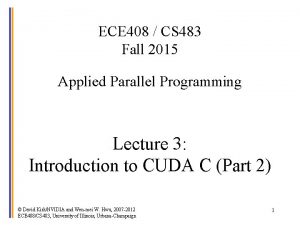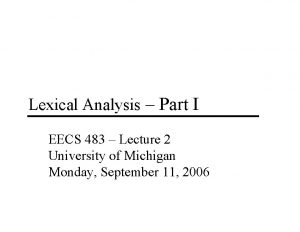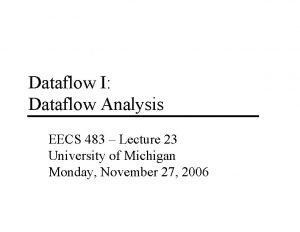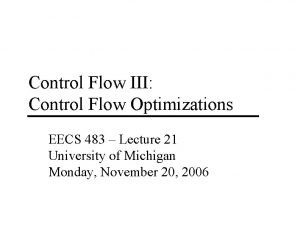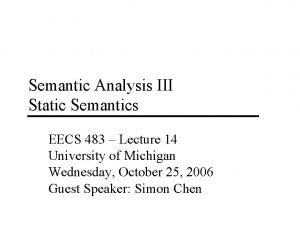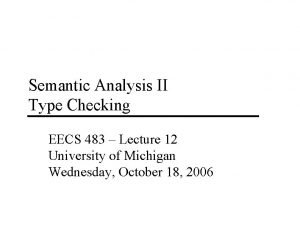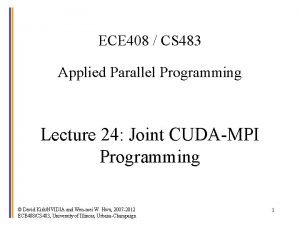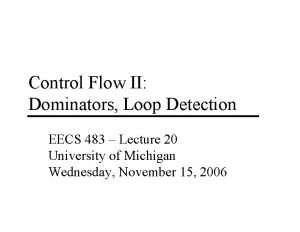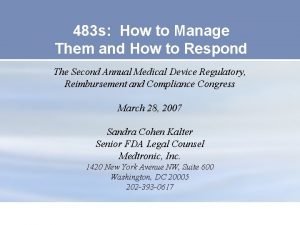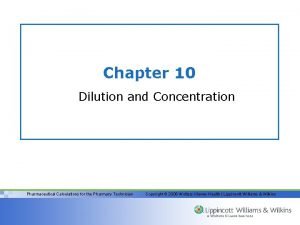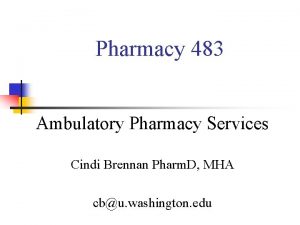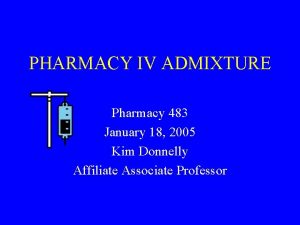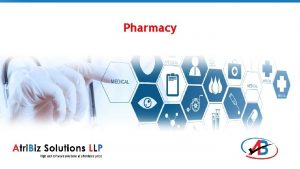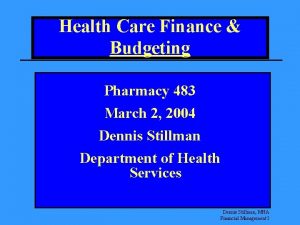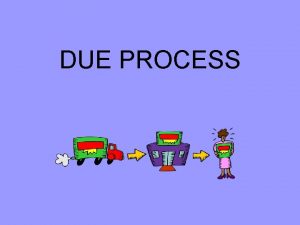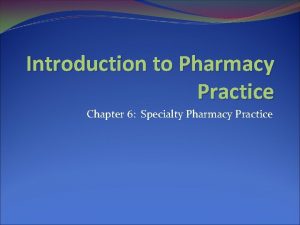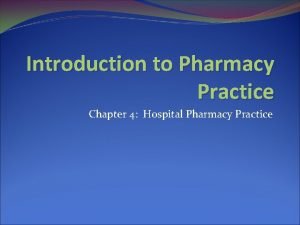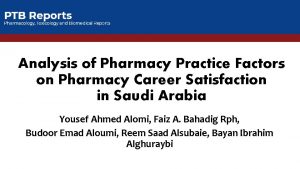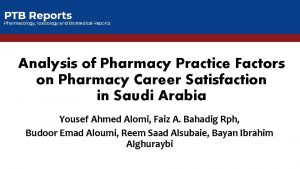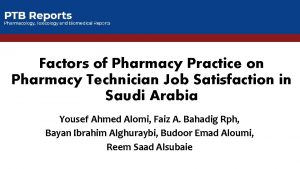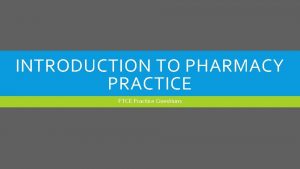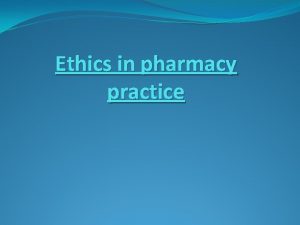Pharmacy 483 QI and DUE in Pharmacy Practice























- Slides: 23

Pharmacy 483: QI and DUE in Pharmacy Practice Steve Riddle, BS Pharm, BCPS QI and Medication Utilization Lead HMC Pharmacy February 24, 2004

Acute Myocardial Infarction • HA, 52 yo male admitted via ER with severe, “crushing chest pain”, ST elevation with positive enzyme elevations. • What should be done for this patient?

Why do we need QI in pharmacy or in healthcare

How do we assess quality? • Quality Assurance (QA): quality assurance is any systematic process of checking to see whether a product or service is meeting specified requirements – Implies “maintenance of standard” • Quality Improvement (QI) – Focus is on improvement of product or service or process

Continuous Quality Improvement (CQI) “Doing things right first time" • Implies that there is only one way to do something and that good quality care is static and unchanging. • It is essential to strive for continuous quality improvement and not to assume that because things are "done right first time" they cannot be done better.

Three Categories of Quality Improvement • Eliminating quality problems – Remove unsafe on ineffective agents from formulary – Facilitating use of most appropriate agent – Reducing order-drug turnaround times (ie, automation) • Reducing costs while maintaining or improving quality – Optimize drug acquisition cost: contract negotiations, Group Purchasing Organizations (GPOs) – Therapeutic substitution initiatives (ex. , PPIs) – Generic utilization • Expanding customer expectations – Development of innovative products and services to attract customers (ie, CDTM, mail order)

QI Methodology Many QI theories or methods. Most share key steps…. • Identify What are you improving? • Analyze Understand the problem(s) • Develop Hypothesize solutions/changes • Test or Implement Put it into practice • Assess Outcomes What worked? • Sustain Hold the gains • Spread Broaden scope of gains

AMI Treatment: 3 QI Examples In Pharmacy. #1 Disease State Management #2 Pharmacologic Class Review #3 Drug Use Evaluation (DUE)

AMI Drug Treatment: Assessing Quality Indicators • What are goals? – Current Clinical Recommendations (AHA & NCEP Guidelines) – Benchmarking (CMS Data, UHC) • Review patient data for EBM drug indicators – Retrospective: Disch Dx (ICD-9 Codes), – Prospective (”Real Time”) • Identify areas for improvement – Where are major deficiencies?

Quality of Care for AMI: Disease State Management Focus on provision of key elements of care that optimize outcomes • Interventions (Arteriogram, PCTA, CABG) • Labs and Diagnostic Eval. (ECG, enzymes, Echo, EF) • Messages (Life Style Modification, Smoking Cessation, Medication Adherence) • Drug Therapy (Thrombolytics, Heparin, GP-2 B 3 A inhibitors, ASA, ACEIs, Beta-Blockers, Statins) • Timeliness of therapy (door-to-drug)

HMC Care Goals for AMI Measure Goal Sampling Plan AMI patient discharged on ASA AMI patient discharged on ACEI 100% Chart Review AMI patient discharged on Beta Blocker AMI patient discharged on Statin (if LDL > 130) 100% Chart Review Smokers with CV Condition will have documented cessation advice/counseling 75% Chart and CIS documentation review

HMC Rx Rates : Secondary Prevention in AMI Percent of Patients 100 86 86 80 64 60 50 40 18 20 0 ASA Beta blocker ACEI Report from 10/2000, UHC Benchmarks Statin Smoking Cessation

AMI Treatment: Indicated Drugs Under Utilized? • • Problems Provider lack of awareness of benefits Inconsistencies in prescribing habits Lack of use of current prescribing aids Complex processes • • • Solutions education/awareness of providers Simplify processes order sets, clinical pathways Designate specific responsibilities Clinical Care Coordinator or pharmacist on clinical team Use data (ie, daily admit printouts)

Pharmacist Role • Collaborate in development of practice guidelines – – • Influence prescribing patterns – – • Committee involvement Standing order and clinical pathway development Daily rounding or clinic interactions Conduct educational programs for residents Provide feedback to prescribers around specific drugs “Counter-detailing” Perform direct patient care roles – – – Anticoagulation service Collaborative disease management protocols Patient education programs

HMC Rates for Secondary Prevention in AMI Percent of Patients 100 94 94 86 100 80 74 60 40 20 0 ASA Beta blocker ACEI Statin Data from HMC Dsch Diagnosis Coding for AMI and CIS reviews 10/2002 Smoking Cessation

ACEI Class Review • Clinical Efficacy – – Numerous agents Varying degrees of literature support FDA approved indications Theoretical differences vs. hard outcomes vs. missing data – “Class Effect”? • Cost – Low-cost generics vs. brand – Pharmaceutical company detailing • Convenience – Once daily vs. BID dosing

Drug: Market Share and Annual Cost: Jan – Dec 01 ACEI Agent Market Share on Utilization (%) #1 Benazepril 36 47. 5 119, 000 #2 Lisinopril 40 41. 0 103, 000 #3 Enalapril 23 10. 1 25, 000 #4 Ramipril 0. 1 0. 5 1, 500 #5 Captopril 1 0. 3 700 TTL Market Share on Cost (%) Annual Cost ($) $249, 200

Drug Use Evaluation (DUE) • Definition: Authorized, structured, ongoing review of practitioner prescribing, pharmacist dispensing and patient use of medications. • Purpose: To ensure drugs are used appropriately, safely, and effectively to – Improve patient care – Lower the overall cost of care – Foster more efficient use of health care resources • Process – Comprehensive review of medication use data – Identify patterns of prescribing

DUE Targets • Therapeutic appropriateness • Appropriate generic or FLA utilization • Inappropriate dose and/or duration • Over and underutilization • Compliance with polices/guidelines

DUE: Ramipril • Restrictions: – Limited Indications: HOPE Criteria – Cost: Trade name vs. generic alternatives • Appropriate Use – Chart reviews of users – Compare actual use to restriction criteria – Percent compliance rate • Assessment

Ramipril DUE Results Total # of Patients Receiving Ramipril 40 # Patients that met HOPE Criteria 33 # of Patients not meeting HOPE Criteria 6* HMC 34 28 5* UWMC 6 5 1 Overall, a 82. 5% compliance rate for appropriate use. Of the 6 patients not meeting the HOPE criteria for ramipril use: -3 had only 1 identified risk factor (hypertension). -3 had documented EF < 40% secondary to MI or CHF along with numerous other risk factors and would have been eligible for treatment with 1 st –line formulary agents.


QUESTIONS?
 Parallelogramma con quattro angoli retti
Parallelogramma con quattro angoli retti Liberty chapter 20
Liberty chapter 20 Grande rhetra
Grande rhetra Principio di conservazione della quantità di moto
Principio di conservazione della quantità di moto Ley notarial bolivia
Ley notarial bolivia Uiuc cs 483
Uiuc cs 483 Biba n 483 ddl
Biba n 483 ddl Eecs 483 umich
Eecs 483 umich Liveness analysis calculator
Liveness analysis calculator Sebuah lampu natrium 20w berwarna kuning
Sebuah lampu natrium 20w berwarna kuning Eecs 483
Eecs 483 Documentos extraprotocolares
Documentos extraprotocolares Ley del notariado 483
Ley del notariado 483 Rule of inference
Rule of inference 오라클 프로시저 cursor
오라클 프로시저 cursor 483 bc
483 bc Kinetics 483
Kinetics 483 Eecs 483
Eecs 483 Ley 483
Ley 483 Ece 408
Ece 408 Dominate
Dominate Fda 483 response cover letter
Fda 483 response cover letter Dilution pharmacy calculations
Dilution pharmacy calculations Practice assessor and practice supervisor
Practice assessor and practice supervisor





